The Panchatantra is an ancient Indian collection of inter-related animal fables in Sanskrit verse and prose. The earliest recorded work, attributed to Vishnu Sharma, dates to about 300 BCE. The fables are likely much older, having been passed down generations orally.
The word “Panchatantra” is a combination of the words Pancha – meaning five in Sanskrit, and Tantra – meaning weave. Literally translated, it means interweaving five skeins of traditions and teachings into a text.
The original text consists of an introduction, followed by five parts or treatises. Each part consists of a primary frame story, which in turn contains stories within it. Often these stories contain anecdotes and epigrammatic verses within them – the entire effect not unlike the Kaavads (portable wooden boxed) used by Rajasthani storytellers.
Introduction to the Panchatantra
Whoever learns the work by heart,
Or through the story-teller’s art
Becomes acquainted,
His life by sad defeat—although
The king of heaven be his foe—
Is never tainted.
The Panchatantra is a niti-shastra, or textbook of niti. The word niti means roughly “the wise conduct of life.”
Hundreds of years ago, there lived a king of Amarasakti who had three sons. These three princes were not just foolish, they also hated studying. A wise old man by the name of Vishnu Sharman came along and undertook the task of making the princes masters of the art of intelligent living – niti.
One Vishnusharman, shrewdly gleaning
All worldly wisdom’s inner meaning,
In these five books the charm compresses
Of all such books the world possesses.

